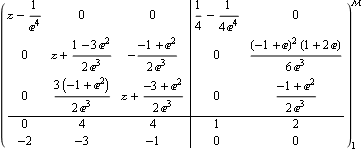Continuous-time system models in state-space form are written as and their discrete-time equivalents are written as where the matrices A and B in Eq. (3.31) are the discrete forms of those in Eq. (3.30). A discrete-time system matrix model, in state-space form, corresponding to Eq. (3.31) is where it is conventional to use the unit delay operator z instead of the continuous-time variable s. This is analogous to Eq. (3.8) for the continuous-time case. The discrete-time formulas for the system matrix in polynomial form, as well as left and right matrix-fraction models, are similarly obtained. Section 3.5 in Control System Professional describes the use of the function ToDiscreteTime for obtaining discrete-time versions of the continuous-time model objects TransferFunction and StateSpace. ToDiscreteTime can also be applied to the new objects SystemMatrix, LeftMatrixFraction, and RightMatrixFraction. In all cases, the domain of the model object is defined by the option Sampled, not the variable s or z. Make sure the application is loaded. Consider the continuous-time SystemMatrix object. | Out[3]= |  |
This is the corresponding discrete-time SystemMatrix model. | Out[5]= |  |
This output format follows the convention in Control System Professional; namely, that the sampling period used (here, T = 1) is indicated by the subscript 1. This convention is also used with LeftMatrixFraction and RightMatrixFraction. This confirms that the system matrix is a discrete-time object. | Out[7]= |  |
| Out[9]= |  |
Here is a RightMatrixFraction object. | Out[11]= |  |
This is the RightMatrixFraction in discrete-time form. | Out[13]= |  |
You can also convert discrete-time objects to any of the other new model formats. This is the LeftMatrixFraction form of the discrete-time RightMatrixFraction object. | Out[15]= |  |
Here is the same result obtained directly by discretizing the continuous-time system matrix object. | Out[17]= |  |
The Control System Professional function ToContinuousTime is used to convert the discrete-time forms of TransferFunction and StateSpace objects to their corresponding continuous-time equivalent forms. The continuous-time forms of the discrete-time forms of the new objects SystemMatrix, LeftMatrixFraction and RightMatrixFraction can also be obtained using this function. Here is a continuous-time TransferFunction object. | Out[19]= |  |
This is the corresponding discrete-time LeftMatrixFraction object, with sampling period T = 2 seconds. | Out[21]= |  |
Here is the continuous-time LeftMatrixFraction equivalent model. | Out[23]= |  |
|